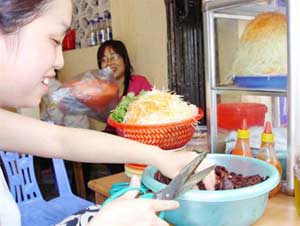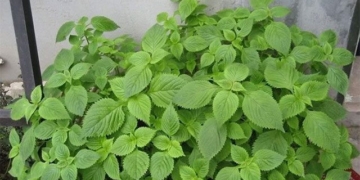Associate Professor Dr. Nguyen Thi Khanh Tram, Deputy Director of the Department of Food Safety and Hygiene at the Ministry of Health, stated that the hot summer weather increases the risk of food poisoning, particularly in perishable packaged foods and ready-to-eat items.
 |
| According to regulations, street food vendors who do not wear gloves, do not wear aprons, and do not use tongs like this will be fined from 100,000 to 300,000 VND. However, people continue to do so without concern. (Photo: N.Ha) |
Since early April, the Poison Control Center at Bach Mai Hospital has been receiving several cases of food poisoning daily. According to Dr. Nguyen Trung Nguyen from the Poison Control Center, the number of food poisoning cases has sharply increased in the past ten days, but this is not an unusual phenomenon.
Early summer marks the season for food poisoning… to rise. Without waiting for the heat to gradually “set in,” any day with an unexpected spike in temperature sees an increase in patients hospitalized due to poisoning.
Dr. Nguyen stated that while the causes of food poisoning from chemicals and natural toxins have significantly decreased, the risk of poisoning from microorganisms continues to rise. Over 80% of food poisoning cases are attributed to animal-based food sources.
At 5 AM on April 10, Ms. Do Quynh Trang, 30, from Giap Bat, Hanoi, was transferred urgently to the Poison Control Center in a state of severe abdominal pain, vomiting, and circulatory disturbances. Ms. Trang was diagnosed with acute poisoning. The previous noon, she had eaten stir-fried veal at a rice shop on Giai Phong Street.
Earlier, Mr. Doan Van Binh (34, Dong Da) had eaten stir-fried noodles with beef at a beer restaurant on Thai Thinh Street; Ms. Tran Thi Bich Loc (Giap Bat, Hanoi) had eaten rice with shrimp, beans, and bean sprouts at a budget rice shop near Giap Bat bus station and also had to be hospitalized due to food poisoning.
The intersection of Buoi and Thuy Khue streets often becomes congested during rush hour due to high traffic volume. However, right next to a construction site filled with dirt and debris, there are many stalls selling intestines and sausages that have formed a “street of intestines” over the past year.
Dr. Tram mentioned that the dust frequently contains microorganisms and molds, combined with the amount of gasoline emissions containing heavy metals. If these are absorbed into food, they can accumulate in the body, leading to gradual poisoning.
Most foods that pose a risk of poisoning contain high levels of fats and proteins. Foods that are not thoroughly cooked, not eaten immediately after cooking, and not stored properly create favorable conditions for bacteria to invade and attack.
In terms of refrigeration, except for the freezer that prevents bacterial growth at 0°C, the cooling compartment only helps slow down bacterial growth at temperatures between 2-8°C, and fruits and vegetables can only be stored for 3-5 days.
Therefore, if too many items are placed in the refrigerator, air cannot circulate, temperatures may not be adequate, raw foods are placed above cooked foods, and food residues, especially meat juices, can remain in the fridge, leading to rapid spoilage and increased risk of poisoning.
NGOC HA



















































